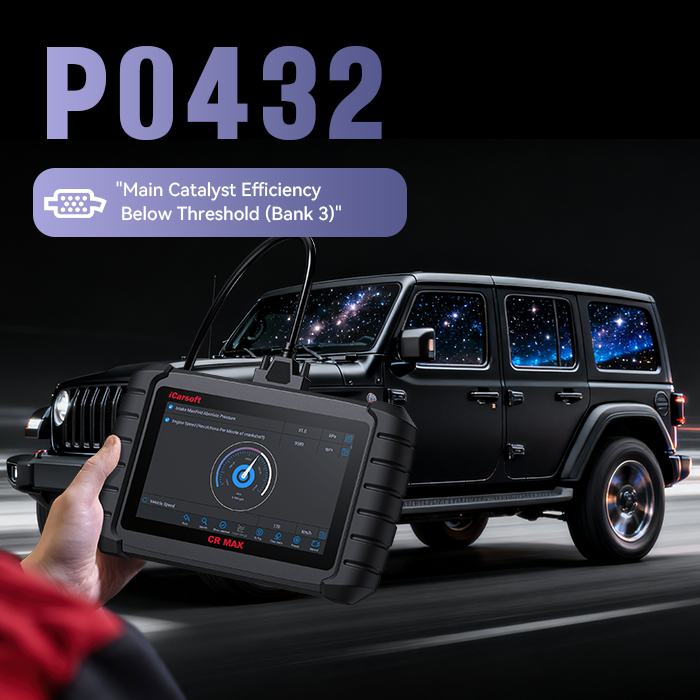Last updated: 2025-10-15
Author: Mike – Porsche DIY Enthusiast since 2012
🔍 What Does Code P0432 Mean?
The P0432 code indicates that the Engine Control Module (ECM) has detected the warm-up catalytic converter on Bank 2 is not performing efficiently enough during initial operation. This typically happens when the catalyst fails to reach its optimal temperature quickly, leading to reduced conversion of exhaust gases.
The P0432 code is very similar to P0431, but it’s logged on different vehicle platforms and may use a different detection threshold. It primarily points to a catalyst efficiency issue on the Bank 2 side of the engine.
Commonly Affected Models: Porsche Macan, Cayenne, 911, Audi A6/A8/Q7, VW Touareg, and other vehicles equipped with V6 or V8 engines.
⚙️ What Causes Code P0432?
- Degraded or contaminated catalytic converter (Bank 2)
- Malfunctioning downstream (post-cat) O2 sensor
- Exhaust leak upstream of the catalytic converter
- Incorrect air-fuel ratio (due to vacuum leak or injector issue)
- Unburned fuel entering the catalyst from a misfire condition
- Old or weak spark plugs, coils, or ignition components
- ECM calibration fault or outdated software (rare)
💡 Tip: Always diagnose O2 sensor performance before replacing the catalyst. A lazy sensor can mimic catalyst inefficiency.
🚨 Symptoms of P0432
- Check Engine Light (CEL) illuminated
- Reduced fuel efficiency
- Noticeable loss in power under acceleration
- Slight sulfur or “rotten egg” odor from exhaust
- Failed emissions or smog inspection
- Rattling noise from inside the catalytic converter (if substrate is broken)
🧰 How to Diagnose and Fix Code P0432
Step 1 – Read and Confirm the Code
Use an advanced scanner such as iCarsoft CR MAX to confirm P0432 and check for related oxygen sensor or misfire codes. Record freeze-frame data to understand when the fault occurred (cold start vs. warm operation).
Step 2 – Inspect for Exhaust Leaks
Leaks at the Bank 2 manifold, flange, or flex pipe can draw in oxygen, confusing the post-cat O2 sensor and triggering a false catalyst inefficiency code. Listen for ticking or hissing sounds when idling.
Step 3 – Check O2 Sensor Performance
Use the scanner’s live data mode to compare the pre-cat and post-cat O2 signals. The pre-cat sensor should fluctuate rapidly between 0.1–0.9V, while the post-cat sensor should remain relatively stable around 0.6–0.8V. If both signals fluctuate similarly, the catalyst is not storing oxygen properly.
Step 4 – Measure Catalyst Temperature
Monitor the converter’s inlet and outlet temperatures with an infrared thermometer or live PID data. A healthy catalyst should show a rise of 100–200°F at the outlet once warmed up. If there’s little to no difference, the catalyst is inefficient or clogged.
Step 5 – Replace or Repair as Needed
If sensors and wiring are verified, the Bank 2 catalytic converter may be internally damaged or chemically inactive. Replace with an OEM or CARB-approved part. After replacement, clear codes and perform a 15–20 minute drive cycle for readiness monitors to reset.
🧩 Recommended Tools:
– iCarsoft CR MAX
– Infrared thermometer
– Digital multimeter
– Exhaust backpressure gauge (optional)
🧠 Technical Insight: How the ECM Evaluates Catalyst Performance
The ECM monitors oxygen storage capacity by comparing upstream and downstream O2 sensor signals during engine operation. A functioning catalyst absorbs and releases oxygen in a way that delays the downstream sensor response. If the downstream sensor signal becomes too similar to the upstream one, it means the catalyst is not storing oxygen properly, triggering P0432.
On many Porsche and Audi systems, the ECM also checks the temperature response rate — a slow warm-up or insufficient temperature rise can also set this code even if the catalyst still functions under steady-state conditions.
❓ FAQ – Common Questions About P0432
Q1: Can I keep driving with P0432?
Yes, but it’s not ideal. A degraded catalyst reduces emissions control and can eventually cause overheating or backpressure issues if ignored.
Q2: How do I know if the O2 sensor is to blame?
If live data shows one O2 sensor stuck at a fixed voltage, or switching abnormally slowly, replace that sensor first. If both O2 sensors behave normally but the code persists, the catalyst is likely at fault.
Q3: Does fuel quality affect P0432?
Absolutely. Poor-quality or leaded fuel can permanently contaminate the catalyst surface, reducing efficiency and triggering this code.
Q4: Will clearing the code fix it?
No. The ECM will re-run the catalyst efficiency test once the vehicle completes its warm-up cycle. If the underlying issue remains, P0432 will return.













